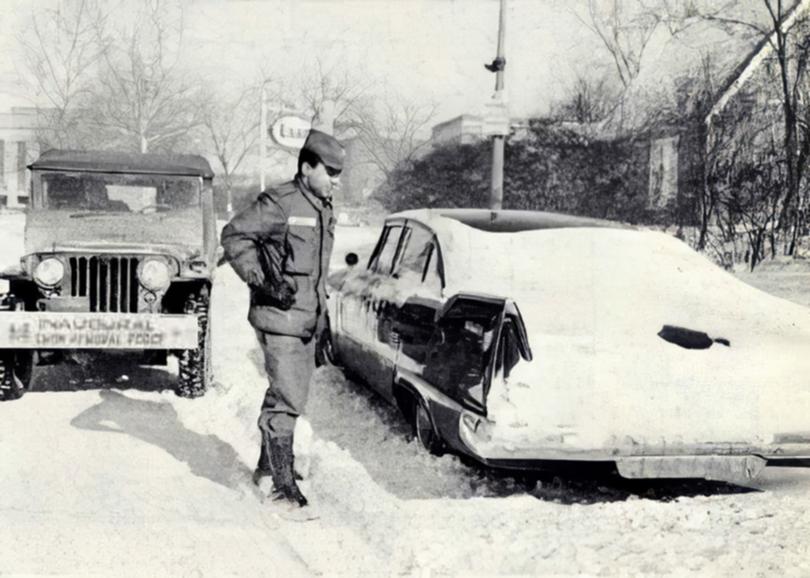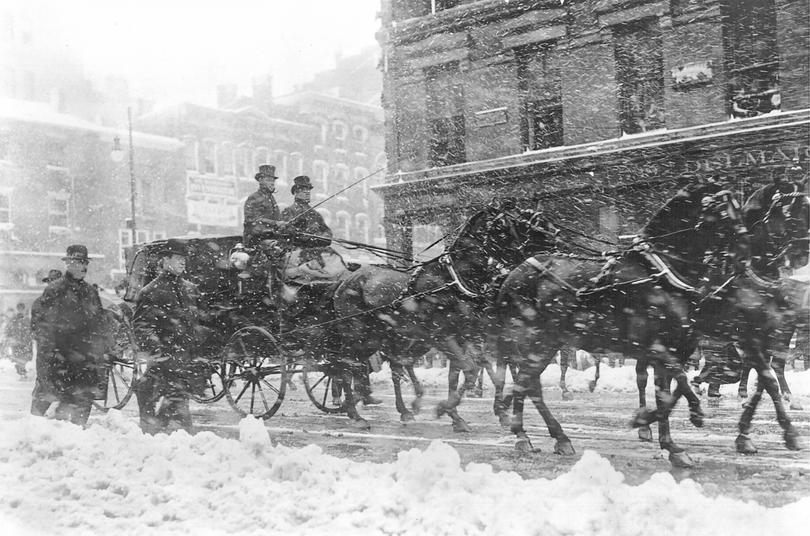Freezing, windy weather forecast for Donald Trump’s presidential inauguration
President-elect Donald Trump’s second inauguration is less than a week away, and early forecasts indicate it could be the coldest since President Barack Obama’s first inauguration in 2009, when temperatures hovered in around minus 2C.
Occurring near the coldest time of the year in the District, inauguration weather is seldom ideal for spending a long time outdoors. Numerous past inaugurations have featured foul weather from bitter cold to snow to driving rain.
The thousands of attendees for Trump’s swearing-in ceremony, set for noon Monday, will not only have to brave cold temperatures, but also a biting wind that could gust to near 48km/h.
Sign up to The Nightly's newsletters.
Get the first look at the digital newspaper, curated daily stories and breaking headlines delivered to your inbox.
By continuing you agree to our Terms and Privacy Policy.Wind chills may hover in the teens.
There’s a chance it could be the windiest inauguration since President Ronald Reagan’s in 1985, when gusts reached 56km/h.
Trump is set to become the 47th president and his running mate, JD Vance, the 50th vice president.
The latest forecast
An Arctic front is poised to sweep through Sunday, and frigid air will flow into the DC area in its wake.
The average temperature predicted by computer models at noon - when the swearing-in ceremony occurs - is around 0C degrees. However, some computer models forecast even lower temperatures, hovering near minus 6. If these colder models are correct, this inauguration would be the coldest since Reagan’s in 1985.
A stiff wind from the northwest will probably blow at around 16 to 32 km/h, with some gusts to around 48km/h, producing wind chills in the teens.
Precipitation is not anticipated, although some snow showers could fall Sunday or Sunday night ahead of the inauguration. At the moment, substantial accumulation is not expected, but the forecast could change.
Inauguration weather history
Past presidential inaugurations have often been cold and dry. The District’s average high temperature in our current climate for Jan. 20 is 45 degrees, and the average low is 30 degrees.
At noon, temperatures typically hover around 37 degrees, with a wind chill slightly below freezing, according to records kept by the National Weather Service.
Most January inaugurations have been slightly colder than these averages, however. Since 1937, inaugurations have had an average high temperature of 41.1 degrees and an average low of 27.6 degrees. The warmest it’s been in Washington on Jan. 20 was 70 degrees in 1951, but that wasn’t an inauguration year. Surprisingly, no January inauguration has hit 60 degrees; in 2013, the year of Obama’s second inauguration, it hit 62 degrees on Jan. 20, but the event was held Jan. 21 since the 20th fell on a Sunday.
During President Joe Biden’s inauguration in 2021, the swearing-in temperature was 42 degrees as a strong breeze gusted to 28 mph. Just an hour earlier, snow flurries were spotted.
Trump’s 2017 swearing-in marked the fourth-warmest on record in January. The noon temperature was 48 degrees with overcast skies. Very light showers briefly fell shortly after the swearing-in ceremony began.
Until 1937, the inauguration wasn’t held until March 4 (or March 5 if the 4th fell on a Sunday). But even though the inauguration used to happen six weeks later - and closer to spring - many March ceremonies were nearly as cold, if not colder, than many of our modern-day January events.
The warmest and coldest
The warmest and coldest inaugurations occurred four years apart. When Reagan was first sworn in to office in 1981, it was 12.7C degrees, and the temperature in Washington hit 13C that afternoon. Four years later it was a markedly different affair. On January 21, 1985, a blast of Arctic cold forced Reagan to take the oath of office indoors, and the inaugural parade was canceled.
The temperature in DC that morning dropped to minus 20 degrees (a record for the date), and climbed to only minus 13C at noon.
Despite Reagan’s bitter-cold second inauguration, history shows that warmer inaugurations typically favor incoming Republican presidents. The average highs have been 6.3C for Republicans and 3.8C for Democrats.
Wettest and snowiest inaugurations
Typically, there is about a 1-in-3 chance of measurable precipitation in the nation’s capital January 20, and a 1-in-6 chance of precipitation occurring during the ceremony, according to the National Weather Service.
Odds of snow are smaller, with only a 10 percent chance of measurable amounts.
The wettest inauguration ceremony was President Franklin D. Roosevelt’s second inauguration in 1937.
A total of 1.77 inches of rain fell that day (a record for January 20), in what the NWS describes as a washout: “Two hundred thousand visitors came to Washington for the inauguration … It was a cold rainy day … Between 11 a.m. and 1 pm, 0.69 inches (17mm) of rain fell. The ceremony began at 12.23 p.m.
The noon temperature was 33°F (0.56C). At the president’s insistence, he rode back to the White House in an open car with a half an inch of water on the floor. Later, he stood for an hour and a half in an exposed viewing stand watching the inaugural parade splash by in the deluge.”
FDR’s 1937 inauguration was the only time more than an inch of rain fell on the date of the ceremony. Subsequent presidential inaugurations were comparatively tame - until 1961, when a major snowstorm brought nearly eight inches of snow to the nation’s capital the night before John F. Kennedy took office.
Though most of the snow fell January 19, the 1961 inauguration holds the record for “most snow on the ground” among all January ceremonies.

As the sun’s glare reflected off the fresh blanket of snow at Kennedy’s inauguration, it proved too bright for Robert Frost to read a ceremonial poem.
“Vice President Lyndon B. Johnson tried to block the sun with his hat, but Frost abandoned the effort altogether and began reciting ‘The Gift Outright’ from memory,” Biography.com recalls.
Kennedy’s inauguration was memorable for its last-minute snow removal efforts along Pennsylvania Avenue and freezing temperatures, but it wasn’t officially the snowiest presidential inauguration.
That distinction belongs to the inauguration of President William Howard Taft on March 4, 1909, when 9.8 inches of snow fell the day of the ceremony.
The powerful snowstorm, accompanied by blustery winds and whiteout conditions, brought Washington to a standstill and forced most of the ceremony indoors.
The 1909 Inauguration Day remains Washington’s second-snowiest March day on record.
It was also one of several March inauguration days with bitter cold temperatures comparable with what we see in January today.

The second-coldest inauguration (other than 1985) was the second swearing-in of President Ulysses S. Grant on March 4, 1873. The low temperature that morning was a frigid 4 degrees, and the high reached only 20 degrees.
In its historical summary, the National Weather Service writes: “During the day, bitterly cold winds gusted up to 40 mph. By noon, the temperature had risen to 16°F. Wind chill temperatures were -15° (-26C) to -30°F (-34C). Cadets and midshipmen had been standing on the mall for more than an hour and a half without overcoats. Several of them collapsed. When the president delivered his inaugural address, the wind made his words inaudible to even those on the platform with him.”
To this day, the 1873 inauguration remains Washington’s coldest March day on record.
Inauguration weather before official records began
Since official government weather records for Washington did not begin until 1871, the weather during presidential inaugurations before then is based on unofficial reports.
The most dramatic and tragic conditions occurred in 1841, according to the National Weather Service. In blustery weather, President William Henry Harrison delivered a one hour and 40 minute speech and rode to and from the US Capitol without a hat or overcoat. He died just one month later after developing pneumonia.
The National Weather Service maintains a detailed list of anecdotal weather reports for all inaugurations dating back to that of George Washington. It’s worth a read, for history buffs and weather enthusiasts alike.
Special to The Washington Post
